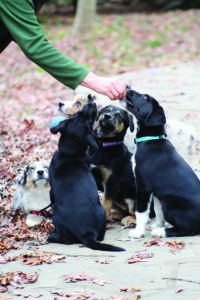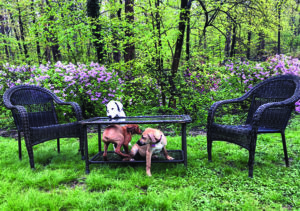
If there’s one thing that can serve as the magic elixir of puppyhood, it’s the puppy playdate. Half an hour spent wrestling and chasing with the right canine friends, a couple times a week, will have an enormous payoff in both the short and long term. However, making sure these critical experiences are positive takes some forethought. Don’t blow it, because a bad experience is just as formative as a good one.
YOU’RE NOT OFF-DUTY
Playdate Rule #1 is that the humans are very much on duty at all times. While it’s true that this activity will buy you some time off, that only happens afterward, when your pup crashes on the couch back at home for two hours. During the playdate itself, you’ll need to be switched on.
If your plan is to let the puppies “work it out themselves,” you’re better off skipping the experience, because it could backfire completely. Instead, be ready to help your pup navigate this new situation. Here’s how:
* The first minutes are key! Be ready to focus on your dog the instant you arrive – even though your manners will be telling you to go over and greet the humans. Here’s the perfect scenario: You wave to the humans as they call their dogs away from the gate, so that your pup can enter and get the lay of the land before interacting. Once your pup is happily integrated into play, you can relax and chat. But keep your eyes on your dog!
* Be a keen observer. Ideally, you’ll see some loose, waggy bodies, a play-bow, and reciprocal action where the chaser becomes the chasee, and the top wrestler takes a turn on the bottom. In contrast, stiff bodies and cornered dogs mean it’s time for you to jump in to help.
* Great doggy play can look a little scary to the uninitiated! If two pups are interacting in a way that concerns you, gently take the pups apart and give them a moment to re-group. Then let go. Do they both happily seek each other out, or does one run for the hills? If they both keep choosing each other, you can feel more confident it’s all good.
* Determine if pups are happily engaging or looking like they want to go home. If a pup seems overwhelmed, step in! If you can’t turn things around in 15 minutes, call it a day and try again later.
A great playdate can be a godsend for humans dealing with an active, mouthy pup who can’t seem to focus. Just like recess at school, allowing a little one to expend energy in an acceptable way helps her to then be able to listen and learn. A vigorous puppy playdate can make a furry “baby alligator” much more pleasant to be around, especially for families with young children at home (since kids are often the ones that get painfully mouthed by pups).
Those short-term gains feel huge at the time, but the truly most important playdate outcomes are the long-term ones. A young pup who has regular positive playdates with a handful of different friends, ideally in a variety of settings, is set up to be a more confident, safer dog forever. His repertoire of doggy communication skills can help him develop into a canine diplomat, easily diffusing tension and avoiding fights. Also, playing with other pups will help him develop the critical “bite inhibition” that keeps him from biting hard later in life. Mouthing is a huge part of doggy play, but pups who bite too hard discover their playmates don’t like it – so they learn to finely calibrate the pressure of their jaws.
When playdates involve a variety of other pups, locations, and humans, a puppy’s world expands. The pup learns to anticipate good things in association with a new place or a stranger. If playdates involve a quick car ride, even better – one more positive link to a new experience. Finally, hosting playdates at home teaches a pup that it’s great fun to have people and dogs over. People with pandemic pups have to work extra hard at this, or they’ll find their dogs are stunned when guests finally start coming over.
ACTIVELY INTERVENE
If you are seeing worrisome signals, it’s time to step in and help. Your big tools are motion, redirection, and training:
* WALK! Lead a fun parade around the perimeter. Clap your hands, call all the pups, and start a group hike. Dogs who were, just moments earlier, heading toward a too-intense interaction can suddenly be very companionable as they move together in the same direction – no longer intensely focused on each other but instead discovering new things to smell together.
I sometimes spend the entire first half hour of my puppy socialization classes walking half a dozen puppies around the perimeter of the yard. After that, they’ve had a chance to size each other up, they feel more confident in each others’ presence, and they’ve burned off a bit of energy. They’re ready to play.
* REDIRECT! Redirect any undesired play into something better. Introduce new elements – a ball to chase, a squeaky toy, a baby pool – to distract pups and lead them into different behaviors. A quick, happy interruption of a particular twosome can work wonders.
Mind you, we’re not “correcting” anything. We’re not using scary voices and big “No’s” with pups who are already perhaps a little confused and overwhelmed. Instead, we confidently, cheerily draw them to a new path.

* ASK FOR SITS! Do some training. Call the pups, and reward them for some quick sits, spins, or touches before sending them back to play. It’s a great idea to do this a handful of times during every playdate, but especially when things seem to be veering away from positive play.
It can be reassuring to a nervous dog, and a solid reminder for a confident dog, that listening to you is the most reliable route to the best things in life. If the playdate has felt a little chaotic or confusing to a young pup, a predictable little training moment can help settle him.
Note: At first, dogs may not take treats well in a group. Use more humans if necessary, and/or hold your hands far apart as you reward different dogs simultaneously. Very quickly, they learn that each pup will indeed get his or her fair share, and sitting nicely without grabbing is the fastest path to the treat.
* Know when to use toys – and when not to. If play seems a notch too intense, it sometimes helps to incorporate a toy. It provides just a bit of distance and a spot for teeth that’s not painful. However, many dogs need to be taught how to use toys with their friends. Once you help get them going by dangling, tugging, and throwing, it is darling to watch them prance a toy near a friend, luring them into the new game.
One thing to watch for, though, is that every now and then there’s a young pup whose natural resource-guarding instincts start kicking in around toys. In that case, best to pop the item(s) in question out of sight.
* Use smart yard setup. A private, fenced yard is the ideal puppy playdate setting. It allows you to control which dogs make the guest list and to minimize health risks. (Much-used public areas are more likely to have yucky things like coccidia or giardia lurking in the grass.)
There are many ways to make your space more conducive to good play. A big flat empty square spells trouble! If one pup feels there’s nowhere to hide, and no place to catch his breath, he may decide he has no choice but to stand his ground fiercely, thus creating unnecessary stress.
If you’re lucky enough to have a yard with lots of (sturdy!) bushes and trees, that’s great. But even if not, simply adding some low tables, benches, planters, and an elevated dog bed can help create a great dynamic. Pups need a place to take temporary refuge from the action. It’s okay if your puppy runs to hide under the bench – as long as pretty soon you see her popping her head out, eager to get back in the game.
In addition to providing those key resting spots, the extra elements allow a pup, who otherwise might have been intimidated into a corner, to lead a very fun over-and-under-and-around game of chase. The more familiar the dogs get with the layout of a yard with all sorts of ins and outs, the more fun – and enriching – those chase games become.
* Be selective about the guest list. When you give your dog time with all kinds of dogs (chasers and wrestlers, the pointy-eared, and the floppy-eared), they become fluent in various kinds of play and communication. That works as an inoculation against a future fear-driven freak-out resulting from an inter-canine misunderstanding. As you try to expand your list of playmates, however, you’ll want to consider size and age. With too big of a discrepancy, you can have unintentional injuries.
Keeping a leash on a bigger or more experienced pup at first can help give a smaller or younger dog a chance to size up the situation and communicate with the big pup without being overwhelmed. But the sooner leashes can safely be off, the better, because they do alter behavior and sometimes add unhelpful frustration.
If there is a big size discrepancy between two dogs you’d really like to have as pals, indoor play can be an answer. A 70-lb teenager Lab-mix can sometimes play beautifully with a 15-lb, 3-month-old in the family room, where they’ll do some mouthy wrestling. That same duo could be dangerous outside in a big yard if the big pup gets up too much speed and bowls the little one over.
The bottom line is that the simplest start is with pups in a close age/size range. But after that, be prepared to watch closely and use your best judgment. Some big dogs are geniuses at playing gently, while plenty of medium-sized dogs have such rough styles that they truly need to “play up” with bigger dogs to be safe. It can’t be said enough: Keen observation is the key.
Puppy playdates are particularly helpful for the under-4-month set – you know, the pups who still have all of their needle-sharp teeth! Of course, that’s also the age where pups are not yet fully immunized against parvovirus and distemper. (The series of vaccinations for these common puppy diseases typically finishes up around 16 weeks.)
The 100% safe option is to have playdates only with fully immunized, dog-friendly dogs, in either your yard or the yard of your responsible friend. That other dog will be older and likely bigger than your puppy, but as long as he or she likes puppies, this can still be a wonderful experience. (Follow the tips in the main article.) However, the most fun playdates at that age are with fellow alligators – er, teething puppies. An adult dog won’t necessarily do all the mouthy wrestling that’s so natural to the under-4-months gang.
Is it safe to allow two not-fully-vaccinated puppies to play together? We covered this topic fully in “Infection vs. Isolation Risks With Your Puppy” (WDJ January 2021). In short, it should be safe to get together with a couple or few very responsible owners who, like you, have carefully managed their puppies’ exposures. Today, we know that failing to properly socialize your intelligently managed puppy in those first few critical months is a bigger risk than that of disease.
HOW LONG SHOULD A PLAYDATE BE?
If you’re trying to get the biggest bang for your buck, a 20-minute playdate is the king. You only have to actively supervise for 20 minutes, but every single one of those is wonderfully stimulating and exhausting for your dog. If that’s all you can squeeze in, don’t worry! If every dog on the planet had a daily 20-minute playdate, the number of anxious/destructive/aggressive dogs would plummet.

My favorite playdates are longer, though. As sessions stretch past the 20-minute mark, especially if playmates are new to each other, you’ll start to see the best play of all. Confidence grows as the over-abundance of energy subsides. As trust builds between dogs, they start to figure out what they like to do together. Sometimes pups who seemed like a poor match at Minute 20 are playing beautifully at Minute 40.
Conversely, sometimes pups who’ve been doing well suddenly get snappish – and that can mean they’re simply tired, and it’s time to call it a day. The higher the number of pups involved, the more energy is expended by each. The newer the relationships, the more stimulating (and exhausting) the event will be. Here’s the key – I know you can guess it by now: Observe closely, and you’ll know when it’s time to call it quits.





Good general article on the main points of managing puppy play; however, I wish the author would have included more specific examples of common undesirable behaviors to be on alert for & how to manage or correct them long term. Removing item for resource guarding among other dogs does not change the behavior. Also humping & dominating behaviors indulged in by adolescent puppies was not addressed.